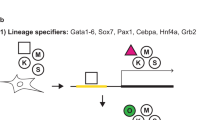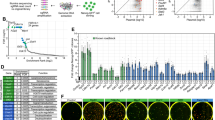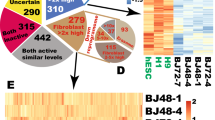Abstract
Embryonic stem (ES) cells are pluripotent and characterized by open chromatin and high transcription levels, achieved through auto-regulatory and feed-forward transcription factor loops1,2. ES-cell identity is maintained by a core of factors including Oct4 (also known as Pou5f1), Sox2, Klf4, c-Myc (OSKM) and Nanog2,3,4, and forced expression of the OSKM factors can reprogram somatic cells into induced pluripotent stem cells (iPSCs) resembling ES cells5,6. These gene-specific factors for RNA-polymerase-II-mediated transcription recruit transcriptional cofactors and chromatin regulators that control access to and activity of the basal transcription machinery on gene promoters7,8. How the basal transcription machinery is involved in setting and maintaining the pluripotent state is unclear. Here we show that knockdown of the transcription factor IID (TFIID) complex affects the pluripotent circuitry in mouse ES cells and inhibits reprogramming of fibroblasts. TFIID subunits and the OSKM factors form a feed-forward loop to induce and maintain a stable transcription state. Notably, transient expression of TFIID subunits greatly enhanced reprogramming. These results show that TFIID is critical for transcription-factor-mediated reprogramming. We anticipate that, by creating plasticity in gene expression programs, transcription complexes such as TFIID assist reprogramming into different cellular states.
This is a preview of subscription content, access via your institution
Access options
Subscribe to this journal
Receive 51 print issues and online access
We are sorry, but there is no personal subscription option available for your country.
Buy this article
- Purchase on SpringerLink
- Instant access to full article PDF
Prices may be subject to local taxes which are calculated during checkout




Similar content being viewed by others
Accession codes
Primary accessions
ArrayExpress
Data deposits
DNA microarray data have been deposited in the public ArrayExpress database under accessions E-TABM-1217 and E-TABM-1218.
References
Efroni, S. et al. Global transcription in pluripotent embryonic stem cells. Cell Stem Cell 2, 437–447 (2008)
Jaenisch, R. & Young, R. Stem cells, the molecular circuitry of pluripotency and nuclear reprogramming. Cell 132, 567–582 (2008)
Chen, X. et al. Integration of external signaling pathways with the core transcriptional network in embryonic stem cells. Cell 133, 1106–1117 (2008)
Kim, J., Chu, J., Shen, X., Wang, J. & Orkin, S. H. An extended transcriptional network for pluripotency of embryonic stem cells. Cell 132, 1049–1061 (2008)
Yamanaka, S. Elite and stochastic models for induced pluripotent stem cell generation. Nature 460, 49–52 (2009)
Hanna, J. et al. Direct cell reprogramming is a stochastic process amenable to acceleration. Nature 462, 595–601 (2009)
Roeder, R. G. Transcriptional regulation and the role of diverse coactivators in animal cells. FEBS Lett. 579, 909–915 (2005)
Fuda, N. J., Ardehali, M. B. & Lis, J. T. Defining mechanisms that regulate RNA polymerase II transcription in vivo . Nature 461, 186–192 (2009)
Goodrich, J. A. & Tjian, R. Unexpected roles for core promoter recognition factors in cell-type-specific transcription and gene regulation. Nature Rev. Genet. 11, 549–558 (2010)
Müller, F., Zaucker, A. & Tora, L. Developmental regulation of transcription initiation: more than just changing the actors. Curr. Opin. Genet. Dev. 20, 533–540 (2010)
Vermeulen, M. et al. Selective anchoring of TFIID to nucleosomes by trimethylation of histone H3 lysine 4. Cell 131, 58–69 (2007)
Juven-Gershon, T. & Kadonaga, J. T. Regulation of gene expression via the core promoter and the basal transcriptional machinery. Dev. Biol. 339, 225–229 (2010)
Cler, E., Papai, G., Schultz, P. & Davidson, I. Recent advances in understanding the structure and function of general transcription factor TFIID. Cell. Mol. Life Sci. 66, 2123–2134 (2009)
Vermeulen, M. et al. Quantitative interaction proteomics and genome-wide profiling of epigenetic histone marks and their readers. Cell 142, 967–980 (2010)
Loh, Y. H. et al. The Oct4 and Nanog transcription network regulates pluripotency in mouse embryonic stem cells. Nature Genet. 38, 431–440 (2006)
Szabó, P. E., Hubner, K., Scholer, H. & Mann, J. R. Allele-specific expression of imprinted genes in mouse migratory primordial germ cells. Mech. Dev. 115, 157–160 (2002)
Chia, N. Y. et al. A genome-wide RNAi screen reveals determinants of human embryonic stem cell identity. Nature 468, 316–320 (2010)
Liu, Z., Scannell, D. R., Eisen, M. B. & Tjian, R. Control of embryonic stem cell lineage commitment by core promoter factor, TAF3. Cell 146, 720–731 (2011)
Sandelin, A. et al. Mammalian RNA polymerase II core promoters: insights from genome-wide studies. Nature Rev. Genet. 8, 424–436 (2007)
Gegonne, A. et al. The general transcription factor TAF7 is essential for embryonic development but not essential for the survival or differentiation of mature T cells. Mol. Cell. Biol. 32, 1984–1997 (2012)
Voss, A. K. et al. Taube nuss is a novel gene essential for the survival of pluripotent cells of early mouse embryos. Development 127, 5449–5461 (2000)
Maston, G. A. et al. Non-canonical TAF complexes regulate active promoters in human embryonic stem cells. eLife 1, e00068 (2012)
Bieniossek, C. et al. The architecture of human general transcription factor TFIID core complex. Nature (2013)
Loh, Y. H., Zhang, W., Chen, X., George, J. & Ng, H. H. Jmjd1a and Jmjd2c histone H3 Lys 9 demethylases regulate self-renewal in embryonic stem cells. Genes Dev. 21, 2545–2557 (2007)
Bilodeau, S., Kagey, M. H., Frampton, G. M., Rahl, P. B. & Young, R. A. SetDB1 contributes to repression of genes encoding developmental regulators and maintenance of ES cell state. Genes Dev. 23, 2484–2489 (2009)
Lessard, J. A. & Crabtree, G. R. Chromatin regulatory mechanisms in pluripotency. Annu. Rev. Cell Dev. Biol. 26, 503–532 (2010)
Singhal, N. et al. Chromatin-remodeling components of the BAF complex facilitate reprogramming. Cell 141, 943–955 (2010)
Sterneckert, J., Hoing, S. & Scholer, H. R. Oct4 and more: the reprogramming expressway. Stem Cells 30, 15–21 (2011)
Munoz, J. et al. The quantitative proteomes of human-induced pluripotent stem cells and embryonic stem cells. Mol. Syst. Biol. 7, 550 (2011)
Acknowledgements
This work is funded by the Netherlands Proteomics Centre, Netherlands Organization for Scientific Research (TOP#700.57.302), Deutsche Forschungsgemeinschaft (DFG Priority Program SPP 1356/2) and the European Union (EUTRACC LSHG-CT-2006-037445). We thank M. Groot Koerkamp and D. van Leenen for microarray analysis, M. de Bruijn and O. Kranenburg for advice on lentiviral knockdown experiments, F. Stewart for help with BAC recombineering, I. Davidson and R. Tjian for TAF cDNA constructs, N. Outchkourov for the GFP-tagging vector, B. Roeder, T. Oelgeschläger and G. Kops for antibodies, M. Stehling for help with the FACS analyses, A. Schambach and C. Baum for the lentiviral OSKM vector, M. Sgodda and T. Cantz for human fibroblasts, M. Radstaak for assistance with human iPSC culture and P. de Graaf, N. Jelluma and M. Vermeulen for critical reading of the manuscript.
Author information
Authors and Affiliations
Contributions
W.W.M.P.P. and H.T.M.T. initiated the project. W.W.M.P.P., D.E., H.Z., A.J.R.H., F.C.P.H., H.R.S. and H.T.M.T. designed the experiments. M.P.A.B. and W.W.M.P.P. performed lentiviral knockdown and mRNA analysis. N.M., A.F.M.A., W.W.M.P.P. and A.J.R.H. performed and analysed the mass spectrometry experiments. W.W.M.P.P. and F.C.P.H. performed and supervised the mRNA profiling experiments. A.J.B. and W.W.M.P.P. performed the ChIP and enhancer analysis. W.W.M.P.P., D.E., E.v.d.W., D.W.H., H.v.B., S.M., H.Z. and H.T.M.T. performed the reprogramming experiments. P.L. and K.S. contributed to the statistical analysis. G.W. performed the animal experiments. W.W.M.P.P. and H.T.M.T. wrote the manuscript. All authors approved the manuscript.
Corresponding author
Ethics declarations
Competing interests
The authors declare no competing financial interests.
Supplementary information
Supplementary Information
This file contains Supplementary Methods, Supplementary Figures 1-33, Supplementary Tables 1-3 and Supplementary References. (PDF 11537 kb)
Rights and permissions
About this article
Cite this article
Pijnappel, W., Esch, D., Baltissen, M. et al. A central role for TFIID in the pluripotent transcription circuitry. Nature 495, 516–519 (2013). https://doi.org/10.1038/nature11970
Received:
Accepted:
Published:
Issue Date:
DOI: https://doi.org/10.1038/nature11970



